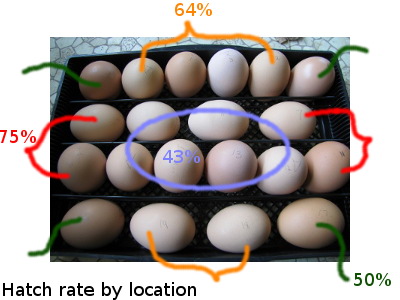I found this very interesting webpage:
http://www.avianaquamiser.com/archives/2011/09/
Anna
Uneven temperatures in incubators
Does egg location in the incubator affect a chick's time of hatch and hatchability? In still air incubators, you'll find relatively wide temperature variations throughout the incubator, but even our top of the line
Brinsea Octagon 20 Advance Incubator shows differences in hatch rate related to egg location in the tray. The picture to the right is the summary of my results from two hatches, suggesting that eggs in the center are less likely to hatch than those around the edges, and my notes show that central eggs also tend to hatch later.
The fan in our incubator keeps air moving, so you would think that all of the eggs would be equally warm. However, a reader on our
homesteading blog suggested that radiant heat from the central heating element preferentially warms the eggs directly underneath. His hypothesis makes a lot of sense, as does his solution of using some kind of barrier like aluminum foil below the heating unit to block the radiant heat while allowing the fans to continue to circulate warmed air. It looks like I'm going to have to do some experiments with moving thermometers around inside the incubator to find out whether there really are high temperature pockets and how to fix them.
Posted early Friday morning, September 2nd, 2011Tags:
chicken incubation
Edited to add:
I'm not knocking the Brinsea, but I did find the article interesting since I have experienced something similar with my RCOM.
 I thought you were saying incubate for 14 days stick in fridge for a few then back in bator lol I was like omg nothing I read said anything bout that lol
I thought you were saying incubate for 14 days stick in fridge for a few then back in bator lol I was like omg nothing I read said anything bout that lol

 Thank you for sharing!
Thank you for sharing!


